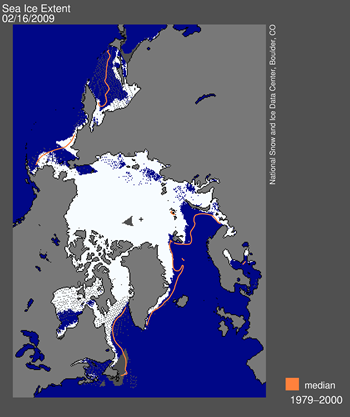Thursday, February 26, 2009
Faulty Sensor causes Arctic Sea Ice Error
 A faulty sensor has caused a slowly growing underestimation of Arctic sea ice extent by the National Snow and Ice Data Center (NSIDC). The underestimation reached approximately 500,000 square kilometers (193,000 square miles) by mid-February.
A faulty sensor has caused a slowly growing underestimation of Arctic sea ice extent by the National Snow and Ice Data Center (NSIDC). The underestimation reached approximately 500,000 square kilometers (193,000 square miles) by mid-February. The problem arose from a malfunction of the satellite sensor. Sensor drift, although infrequent, does occasionally occur.
The daily updates of sea ice coverage rely on rapid acquisition and processing of data from a series of Special Sensor Microwave/Imager (SSM/I) sensors. Because the acquisition and processing are done in near-real time, NSIDC publish the daily data essentially as is. The data are then archived and later subjected to quality control.
"Some people might ask why we don't simply switch to the EOS AMSR-E sensor." said the center. "AMSR-E is a newer and more accurate passive microwave sensor. However, we do not use AMSR-E data in our analysis because it is not consistent with our historical data...There is a balance between being as accurate as possible at any given moment and being as consistent as possible through long time periods."
Arctic sea ice reflects sunlight, keeping the polar regions cool and moderating global climate. According to scientific measurements, Arctic sea ice has declined dramatically over at least the past thirty years, with the most extreme decline seen in the summer melt season.
Further Reading: National Snow and Ice Data Center
What do you think of this news item? Join a discussion.
Labels: environment, SCUBA News